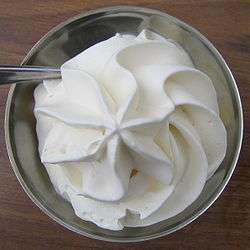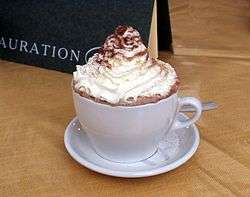Whipped cream
|
A cup of hot chocolate topped with whipped cream from a pressurized can | |
| Type | Cream |
|---|---|
| Main ingredients | Cream |
| Variations | Chantilly cream |
|
| |

Whipped cream is cream that is whipped by a whisk or mixer until it is light and fluffy. Whipped cream is often sweetened and sometimes flavored with vanilla, and is often called Chantilly cream or crème Chantilly (pronounced: [kʁɛm ʃɑ̃tiji]).
Food chemistry
Cream containing 30% or more butterfat can be mixed with air, and the resulting colloid is roughly double the volume of the original cream as air bubbles are captured into a network of fat droplets. If, however, the whipping is continued, the fat droplets will stick together destroying the colloid and forming butter. Lower-fat cream (or milk) does not whip well, while higher-fat cream produces a more stable foam.[1]
Methods of whipping
Cream is usually whipped with a whisk, an electric or hand mixer, or a food processor.
Whipped cream is often flavored with sugar, vanilla, coffee, chocolate, orange, and so on.[2] Many 19th-century recipes recommend adding gum tragacanth to stabilize whipped cream;[3] a few include whipped egg whites. Various other substances, including gelatin and diphosphate (E450), are used in commercial stabilizers.[4][5][6][7]
Whipped cream may also be made in a whipping siphon, typically using nitrous oxide as the gas, as carbon dioxide tends to give a sour taste.[8] The siphon may have replaceable cartridges or be sold as a pre-pressurized retail package. The gas dissolves in the butterfat under pressure, and when the pressure is released, produces bubbles and thus whipped cream.
History
Whipped cream, often sweetened and aromatised, was popular in the 16th century,[9] with recipes in the writings of Cristoforo di Messisbugo (Ferrara, 1549),[10] Bartolomeo Scappi (Rome, 1570),[9] and Lancelot de Casteau (Liège, 1604).[11] It was called milk snow (neve di latte, neige de lait).[12] A 1545 English recipe, "A Dyschefull of Snow", includes whipped egg whites as well, and is flavored with rosewater and sugar.[13] In these recipes, and until the end of the 19th century, naturally separated cream is whipped, typically with willow or rush branches, and the resulting foam on the surface would from time to time be skimmed off and drained, a process taking an hour or more.[1] By the end of the 19th century, centrifuge-separated, high-fat cream made it much faster and easier to make whipped cream. The French name crème fouettée 'whipped cream' is attested in 1629,[14] and the English name "whipped cream" in 1673.[15] The name "snow cream" continued to be used in the 17th century.[16][17]
Various desserts consisting of whipped cream in pyramidal shapes with coffee, liqueurs, chocolate, fruits, and so on either in the mixture or poured on top were called crème en mousse 'cream in a foam', crème fouettée, crème mousseuse 'foamy cream', mousse 'foam',[18] and fromage à la Chantilly 'Chantilly-style cheese'.[19][20] Modern mousses, including mousse au chocolat, are a continuation of this tradition.
Cream whipped in a whipping siphon with nitrous oxide was invented in the 1930s by both Charles Getz, working with G. Frederick Smith of GFS Chemicals,[21][22] and Marshall Reinecke.[23] Both filed patents, which were later litigated. The Getz patents were originally deemed invalid, but were upheld on appeal.[8]
Crème Chantilly
Crème Chantilly is another name for whipped cream. The difference between "whipped cream" and "crème Chantilly" is not systematic. Some authors distinguish between the two, with crème Chantilly being sweetened, and whipped cream not.[24] However, most authors treat the two as synonyms,[25] with both being sweetened,[26][27] neither being sweetened,[3][28] or treating sweetening as optional.[29][30] Many authors use only one of the two names (for the sweetened or unsweetened version), so it is not clear if they distinguish the two.[31]
The invention of crème Chantilly is often credited incorrectly, and without evidence, to François Vatel, maître d'hôtel at the Château de Chantilly in the mid-17th century.[32][33] But the name Chantilly is first connected with whipped cream in the mid-18th century,[34] around the time that the Baronne d'Oberkirch praised the "cream" served at a lunch at the Hameau de Chantilly — but did not say what exactly it was, or call it Chantilly cream.[35][36]
The names "crème Chantilly", "crème de Chantilly", "crème à la Chantilly", or "crème fouettée à la Chantilly" only become common in the 19th century. In 1806, the first edition of Viard's Cuisinier Impérial mentions neither "whipped" nor "Chantilly" cream,[37] but the 1820 edition mentions both.[38]
The name Chantilly was probably used because the château had become a symbol of refined food.[39]
Imitation whipped cream
Imitations of whipped cream, often sold under the name whipped topping or squirty cream, are commercially available. They may be used for various reasons:
- To exclude dairy ingredients:
- for milk allergies
- for vegan diets
- for religious reasons, such as dietary laws forbidding mixing meat with dairy
- To provide extended shelf life (often in the freezer).
- To reduce the price—though some popular brands cost twice as much as whipped cream.[40]
- For convenience.
Whipped topping normally contains some mixture of partially hydrogenated oil, sweeteners, water, and stabilizers and emulsifiers added to prevent syneresis, similar to margarine instead of the butter fat in the cream used in whipped cream.
Uses
Whipped cream or crème Chantilly is a popular topping for fruit and desserts such as pie, ice cream (especially sundaes), cupcakes, cake, milkshakes, waffle, hot chocolate, Jello and puddings. It is also served on coffee, especially in the Viennese coffee house tradition, where coffee with whipped cream is known as Melange mit Schlagobers. Whipped cream is used as an ingredient in many desserts, for example as a filling for profiteroles and layer cakes.[41]
See also
- Alcohol-infused whipped cream
- Cool Whip – a brand of imitation whipped cream
- Dream Whip – a powdered dessert topping mix
- Reddi-wip – a brand of sweetened whipped cream propelled by nitrous oxide
- Schlagobers – Richard Strauss' "Whipped Cream" ballet
References
- 1 2 Harold McGee, On Food and Cooking, p. 32
- ↑ Jules Gouffée et al., Le livre de pâtisserie, 1873 p. 138
- 1 2 Émile Bernard Urbain Dubois, La Cuisine classique: études pratiques, raisonnées et démonstratives de l'Ecole française appliquée au service à la russe, 1868, p. 122: "La chantilly n'est autre chose que la crème double, amenée à consistance, et rendue mousseuse par le travail du fouet et l'action de l'air."
- ↑ Wayne Gisslen, Professional Baking, 2008, ISBN 0471783498, p. 264
- ↑ Alan Imeson, ed., Food Stabilisers, Thickeners and Gelling Agents, 2011, ISBN 1444360337, passim
- ↑ Rose Levy Beranbaum, The Pie and Pastry Bible, 2009, ISBN 1439130876, p. 550
- ↑ "Dr. Oetker Whip It" http://www.oetker.ca/ca-en/our-products/dr-oetker-whip-it/dr-oetker-whip-it.html
- 1 2 Aeration Processes, Inc. v. Lange et al., 196 F.2d 981, 93 USPQ 332, United States Court of Appeals Eighth Circuit, May 20, 1952.
- 1 2 Terence Scully, trans., The Opera of Bartolomeo Scappi (1570): L'arte et prudenza d'un maestro Cuoco; The Art and Craft of a Master Cook, 2008, ISBN 0-8020-9624-7, p. 105, note 2.39, with many menus including "neve di latte servita con zuccaro sopra" 'milk snow with sugar on top', passim
- ↑ Michelle Berriedale-Johnson, Festive Feasts Cookbook (British Museum), 2004, ISBN 0-299-19510-4, p. 33, citing Messisbugo's Banchetti, composizioni di vivande e apparecchio generale
- ↑ Ouverture de cuisine, "Pour faire neige", p. 123 transcription
- ↑ see also Rabelais, Quart livre, LIX, 1552, éd. R. Marichal, p. 241, cited in the Trésor de la langue française
- ↑ Catherine Frances Frere, Prepere newe Booke of Cokerye, 1545 (modern edition 1913) -- cited in Scully
- ↑ Jean-Louis Guez de Balzac, Lettres de Phyllarque à Ariste full text
- ↑ Oxford English Dictionary, 1923, s.v. 'whipped'
- ↑ Dictionarium Rusticum, Urbanicum & Botanicum, 1726, s.v. 'Syllabub' full text
- ↑ Sarah Harrison, The house-keeper's pocket-book, and compleat family cook, 1749, p. 173. full text
- ↑ Alexandre-Balthazar-Laurent Grimod de La Reynière, Néo-Physiologie du gout par order alphabétique ou Dictionnaire générale de la cuisine française, 1839, p. 184
- ↑ "Tante Marie", La Véritable cuisine de famille, comprenant 1.000 recettes et 500 menus, 18??, p. 296 "Crème fouettée (ou Fromage à la Chantilly)"
- ↑ Mrs. Beeton, The book of household management, 1888, p. 927
- ↑ Charles Getz, "Process of making aerated food products", U.S. Patent 2294172A, filed 26 September 1935, issued 25 August 1942 full text; also U.S. Patent 2435682 (continuation in part)
- ↑ George Frederick Smith (1891-1976), Department of Chemistry, University of Illinois
- ↑ Marshall C. Reinecke, "Device for producing aerated expanded food products", U.S. Patent 2120297A, filed 15 August 1935, issued 14 June 1938 full text
- ↑ recipe entitled "Crème fouettée et crème Chantilly", in Robert J. Courtine, ed., Curnonsky: Cuisine et Vins de France, Larousse, 1974, p. 535
- ↑ Le Petit Robert (1972): "Crème fouettée, dite aussi crème Chantilly"
- ↑ La Grande Encyclopédie (1902)
- ↑ Trésor de la langue française, s.v. crème full text
- ↑ Paul Bocuse, La cuisine du marché (1980), p. 414: "Crème Chantilly (crème fouettée)"
- ↑ La cuisine de Madame Saint-Ange (1927), p. 916f: "Crème fouettée dite « crème Chantilly »... Selon le cas, on ajoute du sucre en poudre, vanillé ou non, dans la crème fouettée."
- ↑ Julia Child et al., Mastering the Art of French Cooking, defines Crème Chantilly as "lightly beaten cream", then refers to it as "whipped cream". With added sugar or flavorings, she calls it "Flavored whipped cream" (I:580). In volume 2, one recipe for crème Chantilly is unsweetened (II:422), another is sweetened (II:450).
- ↑ Larousse du XIXe (1878) et le Littré (1872) mention only whipped (fouettée); le Larousse Gastronomique (1938) mentions only Chantilly
- ↑ Stephen Shapiro, "Roland Joffé's Vatel", in Anne L. Birberick, Russell Ganim, Modern Perspectives on the Early Modern: Temps recherché, temps retrouvé , 2005, ISBN 1-886365-54-7 p. 84
- ↑ "Histoire de la Crème Chantilly", web site of the Domaine de Chantilly
- ↑ recipe for "fromage à la chantilly glacé", a sort of ice cream topped with whipped cream, in Menon's Les soupers de la cour, 1755, p. "chantilly" 313-314
- ↑ Mémoires de la baronne d'Oberkirch, vol. 2, p. 112: "Jamais je n'ai mangé d'aussi bonne crème, aussi appétissante et aussi bien apprêtée." "I have never eaten such good cream, so appetising and so well prepared."
- ↑ "Naissance de la crème chantilly", Tables princières à Chantilly, du XVIIe au XIXe siècle, exhibit at the Musée Condé, 16 September 2006 - 8 January 2007 PDF
- ↑ Le cuisinier impérial, ou, L'art de faire la cuisine et la pâtisserie... - A. Viard - Google Books
- ↑ Le Cuisinier Royal
- ↑ Alan Davidson, The Oxford Companion to Food, s.v. 'cream'.
- ↑ Patrick Di Justo, "Cool Whip", Wired Magazine 15:05 (April 24, 2007) full text
- ↑ Wayne Gisslen, Professional Baking, 2012, ISBN 1118254368, p. 260
